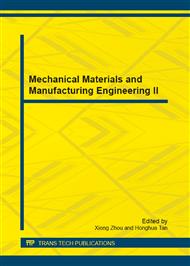[1]
E. Bunting, M. Sheahan, Broken by design?, Yachting World, IPC INSPIRE Ltd, (2009) 66-79.
Google Scholar
[2]
X. Guo-dong, D. Wen-yang, Review of prediction techniques on hydrodynamic impact of ships J. Marine Science Application, 8 (2009) 204-210.
Google Scholar
[3]
J. Lee, P. A. Wilson, Experimental Study Of The Hydro-Impact Of Slamming In A Modern Racing Sailboat, J. ships Marine Science Application, 8 (2009) 204-210.
Google Scholar
[4]
Phelps, B.P. Determination of Wave Loads for Ship Structural Analysis, DSTO Aeronautical and Maritime Research Laboratory, Australia, (1997).
Google Scholar
[5]
T.V. Karman, The impact on seaplane floats during landing - Technical report, Aerodynamical Institute of the Technical High School, Aachen, (1929).
Google Scholar
[6]
M. Ochi, L. Motter, Prediction of slamming characteristics and hull responses for ship design, J. Transactions of SNAME, 81(1973) 144-176.
Google Scholar
[7]
O. Faltinsen, Hydroelastic slamming, J. Marine Science and Technology, 5(2) (2000) 49-65.
Google Scholar
[8]
G. Kapsenberg, A. Veer, J. Hackett, M. Levadou, Aftbody slamming and whipping loads, SNAME Annual Meeting, 111 (2003) 213-231.
Google Scholar
[9]
S. Heller, N. Jasper, On the structural design of planing craft, Transaction of RINA, 103 (1961) 49-65.
Google Scholar
[10]
A. Stavovy, S. Chuang, Analytical determination of slamming pressures for high-speed vehicles in waves, J. Ship Research, 20(4) (1976) 190-198.
DOI: 10.5957/jsr.1976.20.4.190
Google Scholar
[11]
D. Savitsky, P. Brown, Procedures for hydrodynamic evaluation of planning hulls in smooth and rough water, J. Marine Technology, 13(4) (1976) 381-400.
DOI: 10.5957/mt1.1976.13.4.381
Google Scholar
[12]
R. Allen, R. Jones, D. Taylor, A simplified method for determining structural design limit pressures on high performance marine vehicles, Proceedings of AIAA/SNAME Advanced Marine Vehicle Conference, San Diego, (1978).
DOI: 10.2514/6.1978-754
Google Scholar
[13]
P. Joubert, Strength of bottom plating of yachts, J. Ship Research, 26 (1) (1982) 45-49.
DOI: 10.5957/jsr.1982.26.1.45
Google Scholar
[14]
R. Reichard, The structural response of small craft to dynamic loading, Proceedings of the 14th AIAA Symposium on the Aero/Hydronautics of Sailing, 30 (1984) 105-110.
Google Scholar
[15]
M. Hentinen, G. Holm, Load measurement on the 9. 4m sailing yacht sail lab, 13th International Symposium Yacht Design and Yacht Construction, Netherlands, (1994) 131-161.
Google Scholar
[16]
P. Joubert, Tests on yacht hull plating, J. Marine Technology, 33, (1996) 130-140.
DOI: 10.5957/mt1.1996.33.2.130
Google Scholar
[17]
ABS, Guide for building and classing offshore racing yachts, American Bureau of Shipping, (1994).
Google Scholar
[18]
ISO, ISO 12215 Small craft – Hull construction and scantlings, Part 5: Design pressures for monohulls design stresses, scantlings determination. International Organization for Standardization, (2008).
DOI: 10.3403/30038704u
Google Scholar
[19]
BV, Rules for the Classification and Certification of Yachts. Bureau Veritas, (2008).
Google Scholar
[20]
M.K. Ochi, L.E. Motter, Prediction of extreme values of impact pressures associated with ship slamming, J. Ship Res, 13(2) (1969).
Google Scholar
[21]
M.K. Ochi, L.E. Motter, Prediction of slamming characteristics and hull responses for ship design, J. Trans SNAME, (1973).
Google Scholar
[22]
D. W Chalmers, Design of ship's structures, HMSO Publications Centre, London, (1993).
Google Scholar
[23]
N. Jones, Slamming damage, MIT Department of Ocean Engineering, Report No 72-4, (1972).
Google Scholar
[24]
Ship Structure Committee, Hydrodynamic impact on displacement ship hulls, an assessment of the state of the art, SSC 385, (1995).
Google Scholar
[25]
S. R Heller, N.H. Jasper. On the structural design of planing craft, RINA Quarter Trans, (1960).
Google Scholar
[26]
W. Beukelman, Bottom impact pressures due to forced oscillation, Int Shipbuilding Progress, 27(309) (1980).
DOI: 10.3233/isp-1980-2730901
Google Scholar
[27]
P. Manganelli, Experimental investigation of dynamic loads on offshore racing yachts, Ph. D thesis, University of Southampton, UK, (2006).
Google Scholar
[28]
M.R. Ramazani, S. Noroozi, M. Koohgilani, B. Cripps, P. Sewell, Determination of static pressure loads on a marine composite panel from strain measurements utilising artificial neural networks, submitted to Proceedings of the Institution of Mechanical Engineers, Part M: J. Eng. for the Maritime Environment.
DOI: 10.1177/1475090212449231
Google Scholar
[29]
V.B. Rao, H.V. Rao, C++ Neural Networks and Fuzzy Logic, M & T Books, New York, (1995).
Google Scholar
[30]
X. Cao, Y. Sugiyama, Y. Mitsui, Application of artificial neural networks to load identification J. Computers and Structures, 69 (1998) 63-67.
DOI: 10.1016/s0045-7949(98)00085-6
Google Scholar
[31]
L. Ziemianski, G. Harpula, The use of neural networks for damage detection in eight storey frames, Proceedings of the 5th international conference: Engineering applications of neural networks, (1999) 292–297.
Google Scholar
[32]
R. Amali, S. Noroozi, J. Vinney, The application of combined artificial neural network and finite element method in domain problems, Proceedings of the Sixth International Conference on Engineering Applications of Neural Networks (EANN 2000), (2000).
Google Scholar
[33]
R. Amali, S. Noroozi, J. Vinney, P. Sewell, S. Andrews, Predicting interfacial loads between the prosthetic socket and the residual limb for below-knee amputees: a case study, J. Strain, 42(1) (2006) 3-10.
DOI: 10.1111/j.1475-1305.2006.00245.x
Google Scholar
[34]
F. Rosenblatt, The perceptron: a probabilistic model for information storage and organization in the brain Psychological Review, 65(6) (1958) 386–408.
DOI: 10.1037/h0042519
Google Scholar
[35]
S. Shar, F. Palmieri, MEKA: a fast, local algorithm for training feed forward neural networks, Proceedings of the International Joint Conference on Neural Networks, (1990) 41–46.
DOI: 10.1109/ijcnn.1990.137822
Google Scholar
[36]
K. Soo-Young, B.Y. Moon, D.E. Kim, S.C. Shin, Automation of hull plates classification in ship design system using neural network method, Mechanical Systems and Signal Processing 20(2) (2006) 493–504.
DOI: 10.1016/j.ymssp.2004.06.008
Google Scholar
[37]
S. Xu, X. Deng, V. Tiwar, M. A, Sutton, W.L. Fourney, An inverse approach for pressure load identification, International Journal of Impact Engineering, 37(7) (2010) 865–877.
DOI: 10.1016/j.ijimpeng.2009.10.007
Google Scholar
[38]
R. Amali, S. Noroozi, J. Vinney, P. Sewell, S. Andrews, Improvements in the accuracy of an Inverse Problem Engine's output for the prediction of below-knee prosthetic socket interfacial loads, Engineering Applications of Artificial Intelligence, 23(6) (2010).
DOI: 10.1016/j.engappai.2010.02.011
Google Scholar


